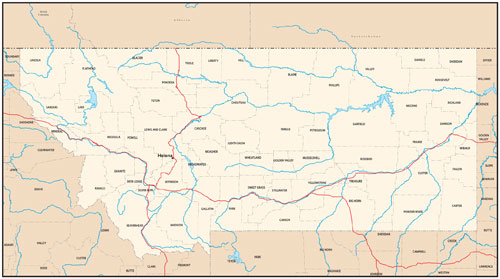Sign up for the Family Tree Newsletter Plus, you’ll receive our 10 Essential Genealogy Research Forms PDF as a special thank you!
Get Your Free Genealogy Forms
"*" indicates required fields
Montana’s American roots begin in the early 1800s, when the United States acquired the part of Montana east of the mountains from France. It was another 40 years before Britain relinquished its claim to the western section of the state.
Established in 1846, Fort Benton was the only trading post to become a permanent settlement. Steamboats brought early travelers there after a trip that took months on the Missouri River from St. Louis or Sioux City.
During the 1850s, Native Americans, adventurous explorers, fur trappers and some missionaries lived there. Jesuit priests founded St. Mary’s, the first mission, in 1841; it would become the center for ranching in the Bitterroot Valley. This early influx of settlers came from all over the world. Homesteaders appeared from the East, the South, and even the West, including Chinese and others who had originally settled in California and Oregon. The discovery of gold in 1862 brought the first major migration to Montana. Gold miners also began to farm. Their earliest settlements include Missoula, Deer Lodge and Bozeman.
The territory of Montana was established in 1864. Railroads reached it in the 1880s, and in 1889, it became a state. In the early 1900s, many homesteaders moved into the eastern part of the state, but drought in the late 1920s and 1930 prompted some to move out.
RESEARCH TIPS
- The Montana Historical Society http://www.his.state.mt.us has a large collection of church, military, prison and institution records, territorial censuses and poll lists.
- In the 1860s, western Montana was in Missoula County, Wash.; eastern Montana was in Nebraska Territory.
- Those living on land now in Yellowstone National Park during the 1880 census were recorded in Wyoming.
CENSUS RECORDS
- Federal census: 1870, 1880, 1900, 1910, 1920, 1930
- Federal mortality schedules: 1870, 1880
- Special census of Civil War Union veterans and widows: 1890
- Territorial censuses: 1860 (see Washington Territory for western Montana and Nebraska Territory for eastern Montana)
GENERAL RESOURCES
- Bibliography of Montana Local Histories by Coburn Johnson (Montana Library Association, 1977)
- Bicentennial Tapestry of the Yellowstone Conference compiled by Doris Whithorn (Meagher County News; Order from D. Whithorn, 1984)
- The Bloody Bozeman: The Perilous Trail to Montana’s Gold by Dorothy M. Johnson (Mountain Press, 1983)
- The Bridger Trail: A Viable Alternative to the Gold Fields of Montana Territory in 1864 by James A. Lowe (Arthur H. Clark Co., 1999)
- A Directory of Churches & Religious Organizations in Montana prepared by the Historical Records Survey (1941)
- First Families of Montana and Early Settlers by Al Stoner (Montana State Genealogical Society, 2000)
- Golden Opportunities: A Biographical History of Montana’s Jewish Communities by Julie L. Coleman (SkyHouse Publishers, ca. 1994)
- Go With Haste Into the Mountains: A History of the Diocese of Helena by Cornelia M. Flaherty (Catholic Diocese of Helena, 1984)
- A History of Montana, 3 vols., edited by Merrill G. Burlingame et al. (Lewis Historical Publishing Co., 1957)
- A History of the Catholic Church in the Pacific Northwest, 1743-1983 by Wilfred P. Schoenberg (Pastoral Press, 1987)
- History of the Great Northwest and Its Men of Progress edited by C.W.G. Hyde and William Stoddard (Minneapolis Journal, 1901)
- Indian and White in the Northwest, or, A History of Catholicity in Montana by L.B. Palladino (J. Murphy, 1894)
- Jesuits in Montana 1840-1960 by Wilfred P. Schoenberg (Jesuits, 1960)
- Men and Trade on the Northwest Frontier as Shown by the Fort Owen Ledger edited by George Ferdinand Weisel (Montana State University Press, 1955)
- Montana Data Index: A Reference Guide to Historical and Genealogical Resources compiled by Paulette K. Parpart and Donald E. Spritzer (Montana Library Association, 1992)
- Montana, Its Story and Biography, 3 vols., edited by Tom Stout (American Historical Society, 1921)
- Montana Legislators, 1864-1979: Profiles and Biographical Directory by Ellis Waldron (Bureau of Government Research, University of Montana, 1980)
- The Montana Locator: A Directory of Public Records for Locating People Dead or Alive in Montana by Laurie Nicklas (L. Nicklas, 1999)
- Montana Pay Dirt: A Guide to Mining Camps of the Treasure State by Muriel Vincent Sibell Wolle (Sage, 1963)
- Montana Research Outline by the Church of Jesus Christ of Latter-day Saints (online at http://www.familysearch.org/eng/search/RG/guide/montana.asp)
- Montana’s Genealogical and Local History Records by Dennis L. Richards (Gale Research Co., 1981)
- More Than Petticoats: Remarkable Montana Women by Gayle C. Shirley (Falcon Press, 1995)
- Names on the Face of Montana: the Story of Montana’s Place Names by Roberta Carkeek Cheney (Mountain Press Publishing Co., 1984)
- The Pioneer Work of the Presbyterian Church in Montana edited by Rev. George Edwards (Independent Publishing Co., 1907)
- Plains, Peaks, and Pioneers: 80 Years of Methodism in Montana by Edward Laird Mills (Binford & Mort, 1947)
- Speaking of Montana: A Guide to the Oral History Collection at the Montana Historical Society compiled by Patricia Borneman, et al, edited by Jodie Foley and Dave Walter (Montana Historical Society Press, 1997)
- Territorial Papers of Montana, 1864-1872 by US Department of State (National Archives, 1963)
- Twentieth-Century Montana: A State of Extremes by K. Ross Toole (University of Oklahoma Press, 1972)
Return to the main Montana page
From the Family Tree Sourcebook
Also available: the State Research Guide Book, State Research Guides CD and The Researcher’s Guide to American Genealogy.
ADVERTISEMENT

